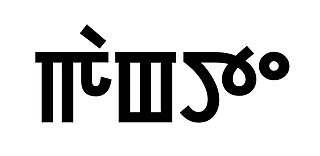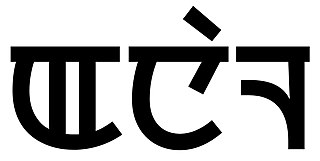
Languages spoken in the Republic of India belong to several language families, the major ones being the Indo-Aryan languages spoken by 78.05% of Indians and the Dravidian languages spoken by 19.64% of Indians; both families together are sometimes known as Indic languages. Languages spoken by the remaining 2.31% of the population belong to the Austroasiatic, Sino–Tibetan, Tai–Kadai, and a few other minor language families and isolates. According to the People's Linguistic Survey of India, India has the second highest number of languages (780), after Papua New Guinea (840). Ethnologue lists a lower number of 456.

Meitei, also known as Manipuri, is a Tibeto-Burman language of northeast India. It is the official language and the lingua franca of Manipur and one of the official languages India. Meitei is the most widely-spoken Tibeto-Burman language of India and third the most used language of northeast India after Assamese and Bengali. There are 1.76 million Meitei native speakers in India according to the 2011 census. Most of these, or 1.52 million, are found in the state of Manipur, where they represent majority of its population. There are smaller communities in neighbouring Indian states, such as Assam (168,000), Tripura (24,000), Nagaland (9,500), and elsewhere in the country (37,500). The language is also spoken by smaller groups in neighbouring Myanmar and Bangladesh.
Hmar is a Kuki ethnic group living in Northeast Indian state of Manipur, Mizoram, Assam and western Myanmar (Burma) and eastern Bangladesh. They use Meitei language as their second language (L2) in Manipur. They speak Mizo language as their L1 in Mizoram.

Gangte is an ethnic group residing predominantly in the Indian state of Manipur, as well as in parts of Mizoram, Assam, and Myanmar. Also part of the larger Zo people, and are recognized as a tribe in both Manipur and under the Indian Constitution. As of as of 2018, their global population is estimated to be approximately 40,000. Their primary settlements in India are located in Churachandpur district of Manipur and in neighboring states, including Meghalaya, Mizoram, and Assam. The Gangtes predominantly use the Meitei language as their second language (L2).
The Koireng people are one of the ethnic groups inhabiting Manipur in North-East India. They speak the [Koireng language]. They are mentioned in the Meitei royal chronicle Cheitharol Kumbaba in the year 1404, one of the oldest tribes to be so mentioned. They have a shared common ancestry, history, cultural traits, folklore and dialects with their kindred people like Aimol and Kom. They use Meitei language as their second language (L2) according to the Ethnologue.

Anāl, also known as Namfau after the two principal villages it is spoken in, is a Northern Kukish language, part of the Sino-Tibetan language family, spoken by the Anal people in India and a dwindling number in Burma. It had 13,900 speakers in India according to the 2001 census, and 50 in Burma in 2010. The speakers of this language use Meitei language as their second language (L2) according to the Ethnologue.

The Kabui people, are a Tibeto-Burman indigenous ethnic group in the Northeast Indian state of Manipur. They are politically categorised as a part of the Naga people of North-East India. They are recognised as a scheduled tribe (STs) by the Constitution of India. They use Meitei language as their second language (L2) according to the Ethnologue.

The Purums are a Tibeto-Burman indigenous ethnic group of Manipur. They are notable because their marriage system is the subject of ongoing statistical and ethnographical analysis; Buchler states that "they are perhaps the most over-analyzed society in anthropology". Purums marry only in selected sibs; the allowed sibs are fixed by traditional customs. The Purums are divided into five sibs, namely, Marrim, Makan, Kheyang, Thao and Parpa. There is no indigenous centralized government. They use Meitei language as their second language (L2) according to the Ethnologue.
The Kom people are one of the indigenous ethnic groups, who had settled in Manipur. They share very similar traditional attires and surnames with Lamkang.The Kom tribes have Karong, Serto, Leivon and Tellien clans etc.They are mainly found in Manipur of North-East India. They use Meitei language as their second language (L2) according to the Ethnologue.

The Chothe people is one of the Naga ethnic group found in the state of Manipur, India. Some historians and anthropologists have erroneously recorded the Chothe as the Purum of India. They are listed as a Scheduled Tribe, in accordance with The Scheduled Castes and Scheduled Tribes Orders (Amendment) Act, 1976 Indian Constitution. They use Meitei language as their second language (L2) according to the Ethnologue.

Tangkhul is a Sino-Tibetan language of the Tangkhulic branch, spoken in different villages of Ukhrul district, Manipur, India. The term "Tangkhul" is derived from the Meitei language terms, "Tang" meaning "scarce" and "Khul" meaning "village" respectively. According to another theory, the term "Tangkhul" is derived from "Thankhul", meaning "Than village" in Meitei language.

The Kharam people, also known as the Kharam Naga, are a Tibeto-Burmese ethnic group inhabiting the Northeast Indian state of Manipur. They are recognised as a Scheduled Tribe (STs) by India. They use Meitei language as their second language (L2) according to the Ethnologue.

Chiru (Naga) is a Southern Naga language spoken mostly in Manipur. The Chiru population numbers approximately 8,599. It is an endangered spoken in three districts of Manipur: Senapati, Noney district of Manipur and Cachar district of Assam. Chiru has been recognized as a Scheduled Tribe of Manipur by the government of India since 1956 under "The Scheduled Castes and Scheduled Tribes Orders (Amendment) Act, Act No. 63 of 1956" Dated 25 September 1956. The total population of the native speakers of Chiru is only 8599. The native speakers have high proficiency in Meitei language. The language is neither used in schools nor in radio or mass media. Older people read and write in Meitei language. The younger generation of Chiru speakers prefers Roman script. The speakers of this language use Meitei language as their second language (L2) according to the Ethnologue.

Monsang is an unclassified Sino-Tibetan language spoken in the Northeast of India. Scott DeLancey, et al. (2015) classifies Monsang as a "Northwest Naga" language. The speakers of this language use Meitei language as their second language (L2) according to the Ethnologue.

Tarao, Taraotrong or Tarau is an unclassified Tibeto-Burman language of India. It is marginally (70%) intelligible with Chothe. The speakers of this language use Meitei language as their second language (L2) according to the Ethnologue.

The Moyon people, also known as Bujuur people or the Moyon Naga, are a Tibeto-Burmese ethnic group predominantly resides in the Northeast Indian state of Manipur and, some in Sagaing Region in Myanmar. They are listed as a Scheduled Tribe (STs) by India. They use Meitei language as their second language (L2) according to the Ethnologue.

Chiru people is a Zo ethnic group that mostly resides in Manipur and some in Assam, India. They are listed as a Scheduled Tribe, in accordance with The Scheduled Castes and Scheduled Tribes Orders (Amendment) Act, 1976 Indian Constitution. They use Meitei language as their second language (L2) according to the Ethnologue.

The Lamkang people, also known as the Lamkang Naga, are a Tibeto-Burman linguistic ethnic group predominantly inhabitanting the Northeast Indian state of Manipur, and some parts of Sagaing Region in Myanmar. They are recognised as a Scheduled Tribe (STs) by India. They use Meitei language as their second language (L2) according to the Ethnologue.

The Taraos are one of the lesser-known tribes of Manipur mostly settled in Chandel district of Manipur. They use Meitei language as their second language (L2) according to the Ethnologue.
Meitei language, the sole official language and the lingua franca of Manipur, one of the scheduled languages of India, one of the recognised educational and literary languages of Assam and Tripura states, has its speakers spread across entire India.















